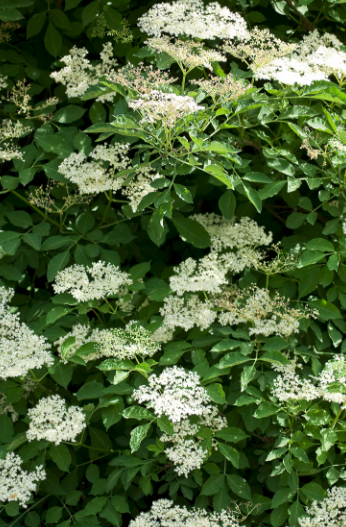Common Names: European elder, black elder, elderberry, elder flower, sambucus
Background
- European elder is a tree native to Europe and parts of Asia and Africa, and it also grows in the United States. The name “elder” comes from the Anglo-Saxon word “aeld,” meaning fire. The terms “elder flower” and “elderberry” may refer to either European elder or a different herb called American elder. This fact sheet focuses only on European elder.
- Various parts of the elder tree, including the bark, leaves, flowers, fruits, and roots, have long been used in traditional medicine.
- Currently, elderberry and elder flower are used as dietary supplements for flu, colds, constipation, and other conditions.
- The dried flowers (elder flower) and the dried ripe or fresh berries (elderberry) of the European elder tree are used in teas, extracts, and capsules.
How Much Do We Know?
- A small number of studies in people have evaluated European elder for various health conditions. Some of these studies used products that included several ingredients, so the actions of individual ingredients are unclear.
What Have We Learned?
- Although some preliminary research indicates that elderberry may relieve flu symptoms, the evidence is not strong enough to support its use for this purpose.
- A few studies have suggested that combination products containing elder flower and other herbs might be helpful for sinusitis, but because the products contain multiple ingredients, it’s unclear what role, if any, elder flower plays in their effects.
- There’s not enough information to show whether elder flower and elderberry are helpful for any other purposes.
- Researchers funded by the National Center for Complementary and Integrative Health (NCCIH) are studying the antioxidant effects of extracts from elderberry and their possible relevance to the body’s defense against infection.
What Do We Know About Safety?
- The leaves, stems, raw and unripe berries, and other plant parts of the elder tree contain a toxic substance and, if not properly prepared, may cause nausea, vomiting, and severe diarrhea. Because the substance may also be present in the flower, consuming large amounts of the flower might be harmful; however, no illnesses caused by elder flower have been reported.
Keep in Mind
- Tell all your health care providers about any complementary or integrative health approaches you use. Give them a full picture of what you do to manage your health. This helps to ensure coordinated and safe care.
For More Information
NCCIH Clearinghouse
The NCCIH Clearinghouse provides information on NCCIH and complementary and integrative health approaches, including publications and searches of Federal databases of scientific and medical literature. The Clearinghouse does not provide medical advice, treatment recommendations, or referrals to practitioners.
PubMed®
A service of the National Library of Medicine, PubMed® contains publication information and (in most cases) brief summaries of articles from scientific and medical journals. For guidance from NCCIH on using PubMed, see How To Find Information About Complementary Health Approaches on PubMed.
Office of Dietary Supplements (ODS), National Institutes of Health (NIH)
ODS seeks to strengthen knowledge and understanding of dietary supplements by evaluating scientific information, supporting research, sharing research results, and educating the public. Its resources include publications (such as Dietary Supplements: What You Need to Know), fact sheets on a variety of specific supplement ingredients and products (such as vitamin D and multivitamin/mineral supplements), and the PubMed Dietary Supplement Subset
Key References
- Elderberry. Natural Medicines Web site. Accessed at naturalmedicines.therapeuticresearch.com on April 9, 2015. [Database subscription].
- Elder flower. In: Blumenthal M, Goldberg A, Brinckmann J, eds. Herbal Medicine: Expanded Commission E Monographs. Newton, MA: Integrative Medicine Communications; 2000:103-105.
- Elderflower. Natural Medicines Web site. Accessed at naturalmedicines.therapeuticresearch.com on April 9, 2015. [Database subscription].
- Mumcuoglu M, Safirman D, Ferne M. Elderberry. In: Coates PM, Betz JM, Blackman MR, et al., eds. Encyclopedia of Dietary Supplements. 2nd ed. New York, NY: Informa Healthcare; 2010:235-240.
- Vlachojannis JE, Cameron M, Chrubasik S. A systematic review on the sambuci fructus effect and efficacy profiles. Phytotherapy Research. 2010;24(1):1-8.
This publication is not copyrighted and is in the public domain. Duplication is encouraged.










+ There are no comments
Add yours